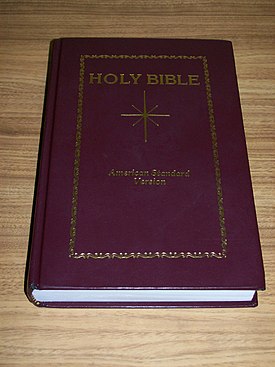American Standard Version
| American Standard Version | |
|---|---|

Star Bible's facsimile reprint of the American Standard Version
|
|
| Full name | Revised Version, Standard American Edition |
| Abbreviation | ASV |
| OT published | 1901 |
| NT published | 1900 |
| Online as | at |
| Derived from | English Revised Version 1881-1885 |
| Textual basis | NT: Westcott and Hort 1881 and Tregelles 1857, (Reproduced in a single, continuous, form in Palmer 1881). OT: Masoretic Text with some Septuagint influence). |
| Translation type | Formal Equivalence. |
| Reading level | High School |
| Version revision | 1929 (copyright renewal) |
| Copyright | Copyright expired |
| Religious affiliation | Protestant inter-denominational |
|
In the beginning God created the heavens and the earth. And the earth was waste and void; and darkness was upon the face of the deep: and the Spirit of God moved upon the face of the waters. And God said, Let there be light: and there was light.
For God so loved the world, that he gave his only begotten Son, that whosoever believeth on him should not perish, but have eternal life.
|
|
The Revised Version, Standard American Edition of the Bible, more commonly known as the American Standard Version (ASV), is a Bible translation into English that was completed in 1901, with the publication of the revision of the Old Testament; the revised New Testament had been released in 1900. It was originally best known by its full name, but soon came to have other names, such as the American Revised Version, the American Standard Revision, the American Standard Revised Bible, and the American Standard Edition. By the time its copyright was renewed in 1929, it had come to be known by its present name, the American Standard Version. Because of its prominence in seminaries, it was in America sometimes simply called the "Standard Bible".
The American Standard Version, which was also known as The American Revision of 1901, is rooted in the work begun in 1870 to revise the Authorized Version/King James Bible of 1611. This revision project eventually produced the Revised Version (RV). An invitation was extended to American religious leaders for scholars to work on the RV project. In 1871, thirty scholars were chosen by Philip Schaff. The denominations represented on the American committee were the Baptist, Congregationalist, Dutch Reformed, Friends, Methodist, Episcopal, Presbyterian, Protestant Episcopal, and Unitarian. These scholars began work in 1872.
Any suggestion the American team had would be accepted by the British team only if two-thirds of the British team agreed. This principle was backed up by an agreement that if their suggestions were put into the appendix of the RV, the American team would not publish their version for 14 years. The appendix had about three hundred suggestions in it.
The New Testament was published in 1881, the Old Testament in 1885, and the Apocrypha in 1894. Around this time, the British team disbanded. Also around this time, unauthorized copied editions of the RV appeared with the suggestions of the American team in the main text. This was possible because while the RV in the UK was the subject of a Crown copyright as a product of the University Presses of Oxford and Cambridge, this protection did not extend to the U.S. and the text was never separately copyrighted there. In 1898, publishers for Oxford and Cambridge Universities published their own editions of the RV with the American suggestions included. However, these suggestions were reduced in number (but it did incorporate all of those suggestions which were listed in the Appendixes, as can be verified by comparing the Appendixes with the main text of the 1898 edition). Some of those Americanized editions by Oxford and Cambridge Universities had the title of "American Revised Version" on the cover of their spines. Some of Thomas Nelson's editions of the American Standard Version Holy Bible included the Apocrypha of the Revised Version. The Revised Version (both the 1885 and the American Standard Version of 1901) are some of the Bible versions that are authorized to be used in services of the Episcopal Church and the Church of England.
...
Wikipedia
